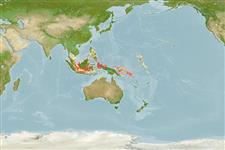>
Eupercaria/misc (Various families in series Eupercaria) >
Caesionidae (Fusiliers) > Caesioninae
Etymology: Pterocaesio: Greek, pteron = wing, fin + Latin, caesius = blue grey (Ref. 45335); monikae: Named for Lady Monika Bacardi...
Environment: milieu / climate zone / depth range / distribution range
Ecologia
marinhas; intervalo de profundidade 0 - 55 m (Ref. 74965), usually 0 - 15 m (Ref. 74965). Tropical
Western Pacific: Cenderawasih Bay, Indonesia.
Comprimento de primeira maturação / Tamanho / Peso / Idade
Maturity: Lm 9.3, range 9 - 9.75 cm
Max length : 9.8 cm SL macho/indeterminado; (Ref. 74965)
Espinhos dorsais (total): 10; Raios dorsais (total): 14-16; Espinhos anais 3; Raios anais : 11 - 12. This species is distinguished by the following set of characters: 2 post-maxillary processes; D X,14-15 (usually 15); A III, 11-12 (usually 12); pectoral rays 20-21(usually 20); lateral-line scales 72-80 (modally 74); scales above lateral line to origin of dorsal fin 6-7 (usually 7); scales below lateral line to origin of anal fin 12-14 (usually 13); circumpeduncular scales, anterior modally 12.14, ventral modally 14.71; body is fusiform in shape and extremely elongate for the genus, greatest depth 4.3-5.1 in SL; HL 3.2-3.6 in SL; snout 4.0-5.2 in HL; eye 2.9-3.6 in HL; pectoral-fin length 1.2-1.4 in HL; in life, color blue, grading to silvery white on belly, with prominent, broad yellow stripe on upper side from dorsal posterior margin of operculum to upper half of caudal peduncle, covering maximum of four scale rows, centered just above lateral line, except entirely above it on caudal peduncle; tip of each caudal-fin lobe with reddish spot (often appearing black underwater), before this is a whitish area (Ref. 74965).
A common species, occurring in large schools with up to several hundred individuals. Observed to be frequently mixed with Pterocaesio pisang and Gymnocaesio gymnopterus. Often occurs on the upper edge of seaward reef slopes, commonly at depths ranging from the surface to about 15 m, but also sighted as deep as 55 m. Unlike other caesionids, when pursued, it hides in nearby crevices and holes within the reef matrix (Ref. 74965).
Ciclo de vida ou comportamento de acasalamento
Maturidade | Reprodução | Desova | Ovos | Fecundidade | Larvas
Allen, G.R. and M.V. Erdmann, 2008. Pterocaesio monikae, a new species of fusilier (Caesionidae) from western New Guinea (Papua and Papua Barat provinces, Indonesia). aqua, Int. J. Ichthyol. 13(3-4):163-170. (Ref. 74965)
Status na Lista Vermelha da UICN (Ref. 130435)
Ameaça para os humanos
Harmless
Uso pelos humanos
Mais informação
ReferênciasAquaculturaPerfil para aquaculturaEstirpesGenéticaElectrophoresesHereditariedadeDoençasProcessamentoNutrientsConversão de massa
ColaboradoresFotosStamps, Coins Misc.SonsCiguateraVelocidadeTipo de nataçãoÁrea branquialOtólitosCérebrosVisão
Ferramentas
Relatórios especiais
Baixar XML
Fontes da internet
Estimates based on models
Preferred temperature (Ref.
123201): 28.4 - 29.2, mean 28.8 °C (based on 329 cells).
Índice de diversidade filogenética (Ref.
82804): PD
50 = 0.5002 [Uniqueness, from 0.5 = low to 2.0 = high].
Bayesian length-weight: a=0.01072 (0.00467 - 0.02458), b=3.12 (2.94 - 3.30), in cm total length, based on LWR estimates for this Genus-body shape (Ref.
93245).
Nível Trófico (Ref.
69278): 3.3 ±0.4 se; based on size and trophs of closest relatives
Resiliência (Ref.
120179): Elevada, tempo mínimo de duplicação da população menor que 15 meses (Preliminary K or Fecundity.).
Fishing Vulnerability (Ref.
59153): Low vulnerability (10 of 100).
